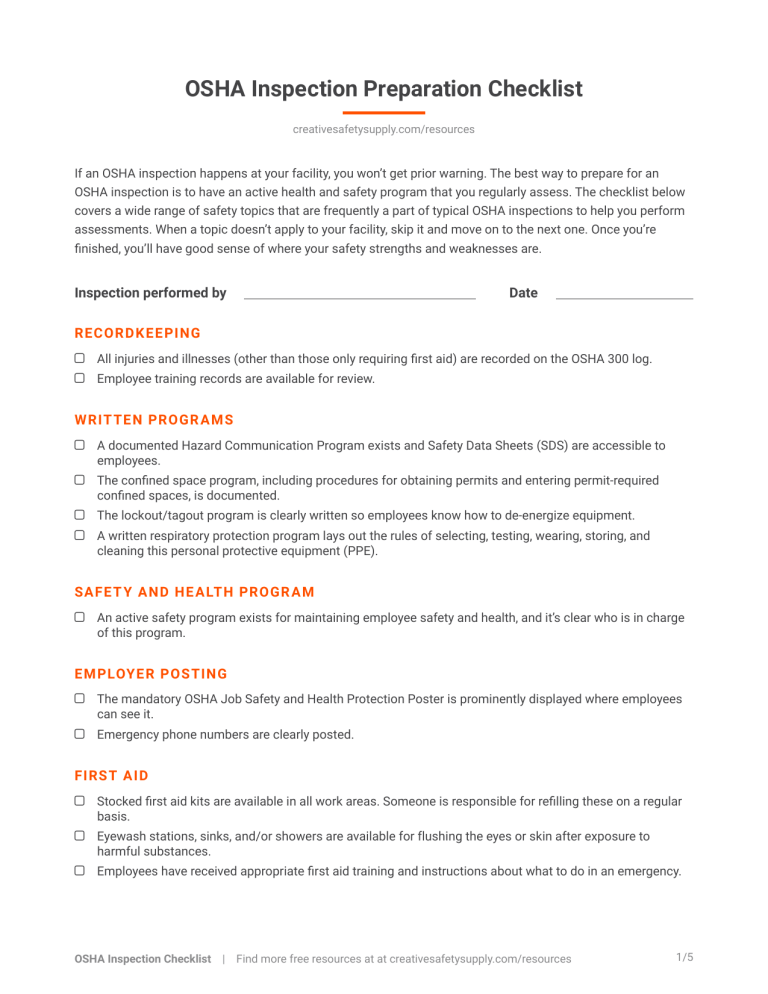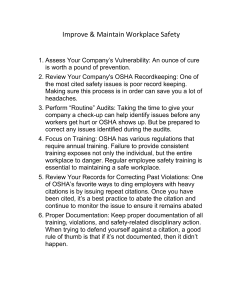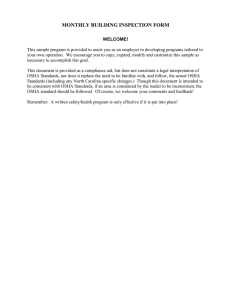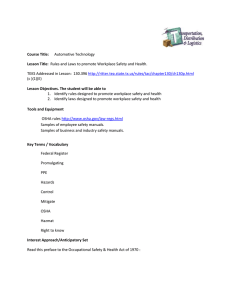
OSHA Inspection Preparation Checklist creativesafetysupply.com/resources If an OSHA inspection happens at your facility, you won’t get prior warning. The best way to prepare for an OSHA inspection is to have an active health and safety program that you regularly assess. The checklist below covers a wide range of safety topics that are frequently a part of typical OSHA inspections to help you perform assessments. When a topic doesn’t apply to your facility, skip it and move on to the next one. Once you’re finished, you’ll have good sense of where your safety strengths and weaknesses are. Inspection performed by Date RECO RDK E E PING All injuries and illnesses (other than those only requiring first aid) are recorded on the OSHA 300 log. Employee training records are available for review. WRIT TE N PROG R A MS A documented Hazard Communication Program exists and Safety Data Sheets (SDS) are accessible to employees. The confined space program, including procedures for obtaining permits and entering permit-required confined spaces, is documented. The lockout/tagout program is clearly written so employees know how to de-energize equipment. A written respiratory protection program lays out the rules of selecting, testing, wearing, storing, and cleaning this personal protective equipment (PPE). SA FE T Y A N D H E A LTH PROG R A M An active safety program exists for maintaining employee safety and health, and it’s clear who is in charge of this program. E M PLOY E R POS TING The mandatory OSHA Job Safety and Health Protection Poster is prominently displayed where employees can see it. Emergency phone numbers are clearly posted. FIRS T AID Stocked first aid kits are available in all work areas. Someone is responsible for refilling these on a regular basis. Eyewash stations, sinks, and/or showers are available for flushing the eyes or skin after exposure to harmful substances. Employees have received appropriate first aid training and instructions about what to do in an emergency. OSHA Inspection Checklist | Find more free resources at at creativesafetysupply.com/resources 1/5 FIRE PROTECTIO N The fire alarm system is certified and tested annually. All fire doors are clear from obstructions. Fire extinguishers of the appropriate type are mounted in accessible locations. Fire extinguishers are regularly recharged, and this is noted on the tag. PE RSO N A L PROTECTIV E EQ U IPM E NT Appropriate PPE such as face, head, eye, hand, and foot protection are available for employees who need to wear it to safely perform their jobs. Procedures exist for testing, storing, and cleaning of PPE. G E N E R A L WO RK E N VIRO N M E NT The workplace is clean and sanitary. The workplace is organized—tripping hazards and other problems associated with a messy workplace do not exist. The minimum amount of restrooms is provided for employees. WA LK WAYS All aisles are appropriately marked and unobstructed. Holes in the walking surface are covered or repaired so people can walk safely. Non-slip materials are used on wet surfaces to improve traction. Walkways that pass by moving equipment or other hazards are positioned so people won’t be exposed to hazards. EG RES S & E VAC UATIO N Exits are labeled with exit signs and illuminated so they’re always visible. Enough exits exist so people can leave quickly during an emergency. All doors and routes that could be mistaken for exits are marked so people aren’t confused about their purpose (e.g. “NOT AN EXIT” or “TO STORAGE ROOM”). All exits are free from obstructions. L A DDE RS All ladders are in good condition and receive maintenance when needed. All employees have received training about how to safely use a ladder. H A N D TOO LS & POWE R TOO LS All tools used in the workplace are in good condition. Moving parts are guarded to prevent injury. Tools are stored in a secure, dry location. OSHA Inspection Checklist | Find more free resources at at creativesafetysupply.com/resources 2/5 M AC HIN E G UA RDING All machinery and equipment is regularly inspected and serviced as needed. Power shut-offs exist within reach of operators. Emergency stop buttons are red. LOC KO UT/ TAGO UT Procedures require that all equipment is de-energized or disengaged and locked out during maintenance or cleaning. WE LDING & C UT TING Compressed air gas cylinders are examined on a regular basis for leaks, rust, or defects. Signs clearly stating smoking, matches, and other ignition sources are not allowed are posted. PPE including eye protection, helmets, goggles, and hand shields meet standards. CO M PRES SO RS/AIR REC E IV E RS Every receiver has a pressure gauge and at least one automatic safety valve. There is a current operating permit. CO M PRES S E D GAS CY LIN DE RS All cylinders are legibly labeled to identify their contents. FORK LIF TS Employees who operate forklifts have received proper training for the trucks they operate. Untrained employees are not allowed to operate forklifts. Forklifts are equipped with warning horns that can be heard above normal noise levels. Brakes can bring trucks to a complete stop even when the truck is fully loaded. CO N FIN E D S PAC ES Permit-required confined spaces are only entered with the proper permit and according to the procedures of the confined space program. Regular tests of the atmosphere are performed before and while people are inside a confined space. An attendant is posted outside confined spaces while work is performed in case of an emergency. Respiratory protection is required if the atmosphere is unsafe. If an emergency occurs, responders only enter the confined space with respiratory protection and a lifeline. E N VIRON M E NTA L CONTROLS All work areas have adequate lighting. Work areas have appropriate ventilation systems. Hazardous substances such as blood and infectious materials are identified. Water for drinking, cooking, and washing is potable. OSHA Inspection Checklist | Find more free resources at at creativesafetysupply.com/resources 3/5 FL A M M A BLE A N D CO M BUS TIBLE M ATE RIA LS Proper storage containers and methods are used to prevent spontaneous combustion of materials. All combustible waste, debris, and scrap is stored in metal containers and removed from the worksite appropriately. H A Z A RD CO M M U NICATIO N & H A N DLING DA NG E RO US S U BS TA N C ES Employees are trained so they understand hazards, can read SDSs and labels, and know how to safely handle chemicals such as acids, bases, caustics, etc. Employees who handle hazardous chemicals must wear appropriate PPE. There is a comprehensive list of hazardous substances used in the workplace and the corresponding SDS for each chemical. Employees are trained so they understand OSHA’s blood borne pathogens standard. E LECTRICA L Electrical equipment is installed appropriately and receives regular maintenance. Necessary labels of electrical hazards are posted on equipment. Employees who will work on or near electrical equipment have received proper training. Temporary wiring such as flexible cords does not cause a tripping hazard. N OIS E Noise levels in the workplace do not exceed 85 decibels. In locations where loud noises occur, employees wear hearing protection. PIPE IDE NTIFICATIO N Outlets and taps attached to pipes with nonpotable water are marked as unsafe for drinking, washing, etc. Where colored painted bands or tapes are used on pipelines, they are spaced at appropriate intervals and at outlets, valves, and connection points. A color code is posted for pipes so employees can see what hazards pipes present. Names and name abbreviations are easily visible on pipe labels. TR A NS PO RTING E M PLOY E ES Vehicles that transport employees have brakes, lamps, mirrors, horns, windshields, and turn signals and are in good condition. Vehicles have handrails, steps, and other devices to help employees mount or dismount. This checklist is not exhaustive, but it will help you evaluate where you’re at. For a more detailed list of specific safety items or areas of interest related to each topic, consult OSHA’s Small Business Handbook. https://www.osha.gov/dcsp/compliance_assistance/quickstarts/general_industry/gi_step3.html OSHA Inspection Checklist | Find more free resources at at creativesafetysupply.com/resources 4/5 Create a safer, smarter facility.™ Creative Safety Supply is your one stop shop for all things Lean and Safety. You’ll find the tools you need to create visual systems that keep your employees safe and your spaces compliant. Choose from SafetyTac® floor marking tapes, LabelTac® industrial label printers, safety equipment, and 5S products to put your workplace on the path to safety and efficiency. Customer favorites SafetyTac® Floor Marking Tapes LabelTac® Label Printers Industrial Floor and Wall Signs Industrial Label Printers Labels Floor Marking Tapes Slip Safety Floor Tapes Foam Tool Organizers Signs Virtual Floor Signs Safety Products Tool Organization Systems The leaders in visual safety.™ Visit us online 24/7 or call us anytime M-F 6am-4pm PST creativesafetysupply.com | 1-866-777-1360 Revealed Series Training DVDs Lean Training DVDs Lean and Safety Posters Large Format Printing PPE Gear



